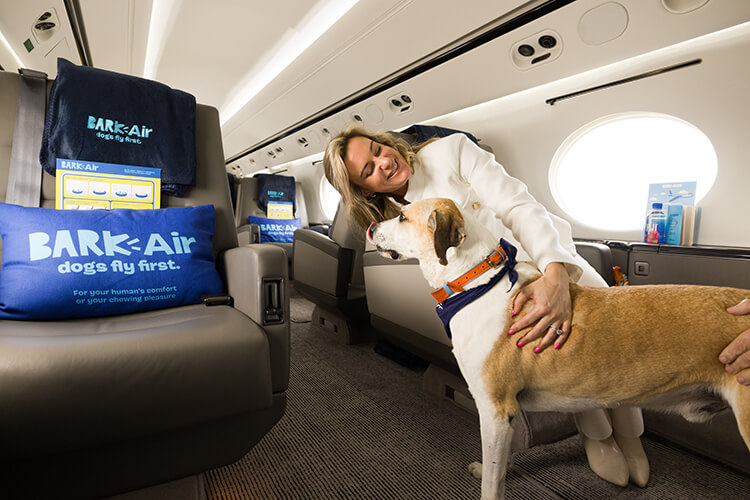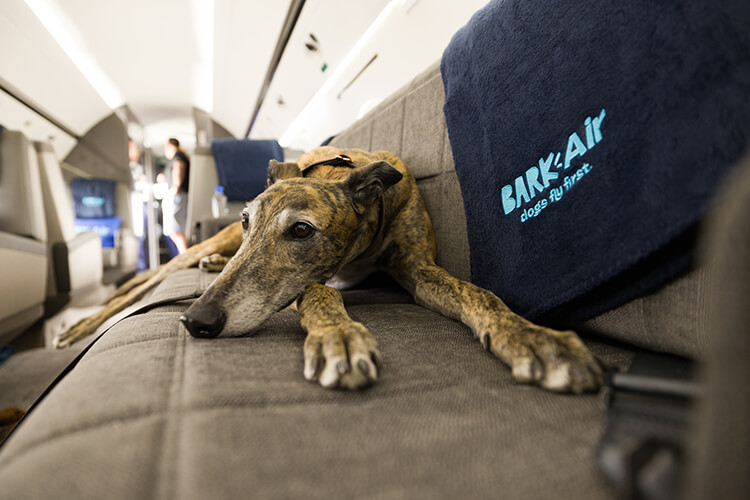“We have a saying at BARK: dogs fly first, humans fly business,” BARK co-founder and CEO Matt Meeker told me as we sat down together to chat about BARK Air.
BARK is the parent company behind the monthly subscription box for dogs, BarkBox, which was founded in 2011. Immensely successful since their start, BARK has always taken the approach that
dogs deserve better. And that philosophy didn’t stop when it came to building BARK’s latest venture. BARK Air promises to be a truly dog-friendly airline created with the comfort of dogs in mind first.
BARK Air’s promo video shows a 747 fitted with an in-air dog park, lay flat beds where dogs can cuddle up with their humans for the flight, and dogs being lavished with doggy champagne and the pawfect sneaker for chewing presented on a silver platter. Humans in seats are replaced by dogs watching the in-flight squirrel entertainment as long strings of drool hang from their mouths.

While the promo video doesn’t paint an entirely accurate picture of what flying BARK Air will really be like at its launch in May 2024, it does bring to life Matt Meeker’s vision for creating an airline for dogs. And if BARK Air can succeed in its infant stage, after spending some time talking with Matt I absolutely believe we will see BARK Air expand to branded airliners with all the dog-centered amenities from the promo video flying dogs around the world.

How BARK Air Works
As Coco and I have flown twice in recent months with K9 Jets, I wanted to sit down with Matt and get the inside scoop about BARK Air and what the experience will really be like.
BARK Air will initially be a pay-per-seat private charter model similar to K9 Jets in which they don’t own or operate any aircraft, but instead handle all the chartering, insurance, and paperwork. The private jet charter company Talon Air, who are industry-recognized for their safety ratings and certifications within the private jet industry, serves as BARK Air’s partner.
The jets are Talon Air owned and operated Gulfstream V ultra-long range jets. It has a maximum capacity of 16 passengers, but BARK Air sets their maximum capacity to 10 passengers + 10 dogs. There are three cabin zones with a small kitchen galley and one bathroom located at the back of the aircraft.
BARK Air’s initial offering flies two routes: one domestic route between NYC via Westchester County Airport (HPN) and Los Angeles via Van Nuys Airport (VNY) and one international route between NYC Westchester County Airport (HPN) and London Stansted (STN). Tickets are on sale on the BARK Air website at $6000 one-way for the NYC – LA route and $8000 one-way for the NYC – London route. Each ticket is all inclusive of taxes and fees, and includes:
- one dog of any size (sorry, BARK Air is for dogs only – no cats allowed) plus one human
- one 22kg (50 lbs) checked bag
- one small carry-on (which will also be stowed in the hold, but the flight attendant can access easily if you need something from it during the flight)
- a personal item such a purse, small backpack or tote bag to be kept with the human at the seat
*If you’re traveling with a spare human, BARK Air also offers a limited number of human tickets at an additional cost. But all humans traveling with BARK Air must be at least 18 years of age.
Similar to K9 Jets pay-per-seat offering, each flight is made up of an outbound and inbound flight. BARK Air needs to sell 60% of the seats for the entire return flight route. But they plan to fly even if the 60% thresholds aren’t met initially. Matt noted that if BARK Air is taking a customer’s payment, they’re committing to flying and getting those dogs booked to their destination. With the publicly-traded billion dollar company BARK as the parent company of BARK Air, they can essentially afford to get flights that don’t meet the minimum threshold in the air at the beginning in order to see BARK Air be successful.

What to Expect When Flying BARK Air
BARK Air is all about making sure dogs fly in the utmost comfort. Dogs of any size are welcome to book a ticket, and there are no breed restrictions. In fact, it’s the larger dogs and snub-nosed breeds that can’t fly in cabin on commercial flights that really inspired BARK Air.
When you book your ticket, you enter details about your dog such as their name, breed, age and weight as well as your own information. Payment is by credit card, and the booking process is all very easy and completed in just a few minutes. After, a BARK Air Concierge contacts customers to talk about your dog’s temperament and any triggers. This information is utilized to create a seating chart for your flight to ensure all dogs on board have a safe and comfortable flight.
The dogs’ humans are still responsible for ensuring you meet all requirements such a vaccinations and microchips, and obtain all necessary animal health certificates to enter your destination. But your BARK Air Concierge will be there to help support you and answer any questions ahead of your flight.
BARK Air flights operate from FBO (meaning Fixed-Base Operator) private airports or from private terminals. Unlike flying commercial airlines, there is no waiting for check-in and long security lines. Even for an international flight, arriving 1 hour ahead of your flight is plenty of time. Check-in and security screening is completed in just a few minutes, and you’ll wait in a private lounge designated just for those traveling on your flight.
A BARK Air concierge is on hand to help every pup and human passenger get checked in. They’ll also help direct doggy socializing ahead of the flight so that the dogs can get to know each other, be able to direct you to the best grass for any last minute potty breaks ahead of the flight, and offer any just-in-case items like calming treats, poop bags and leashes.
As for meals for the humans, BARK Air offers chef-prepared hot meals in the lounge ahead of the flight. Humans are also offered unlimited drinks from the open bar throughout the flight.
On board, dogs are offered pillows and blankets that have been treated with calming pheromones to help them feel settled on the flight and a dog beverage such as water or bone broth as drinking during ascent and descent helps dogs with any ear discomfort they might experience. Dogs are also offered BARK-branded treats, snacks, and more surprises.
Along with the flight attendant, each BARK Air flight has a fear-free certified concierge traveling on board. BARK Air’s first concierge hired for this position is a vet technician, and all concierges will be trained in CPR for dogs to ensure in-air safety.
The whole point of traveling on a charter is that your dog doesn’t need to be crated and can travel right alongside you. The dogs are free to get comfortable as they like, whether that be curled up on a seat, their human’s lap, or sprawled out on the floor. Leashes aren’t required once on board except during takeoff and landing – with one caveat: your dog must be under your voice control.
The flight isn’t meant to be a free for all with the dogs wandering all over the jet, but they are welcome to get comfortable. And in our experience of flying transatlantic flights with nine other dogs aboard, most dogs settle in pretty quickly and mostly nap throughout the entire flight.
Once you’ve landed, BARK Air also includes a dog-friendly car service (within 30 miles of the airport) to help get you on your way to your final destination.

A Path to Lower Prices
While you might initially balk at the price tag, keep in mind that much of the demand for services like BARK Air and K9 Jets currently are people relocating for various reasons such as job relocation who want a safe solution to transporting larger dogs by air.
I’ve been forced to fly a larger dog in the cargo hold for job relocation overseas before services like K9 Jets and BARK Air existed. It was such a stressful process that I vowed never to put an animal through that again, especially after I was also forced to place our cat in the hold on our last flight segment and her crate came out damaged and partially open.
I quite literally moved to France from Italy when Tim was once again relocated to South Korea for a year-long assignment just to avoid flying my senior dog in the cargo hold and flying my senior cat at all. It’s what inspired Matt to dream up BARK Air, too. His own Great Dane, Hugo, is too large to even meet the maximum size requirements commercial airlines impose for dogs flying the hold as excess baggage.
For now, the only alternative to flying larger dogs in the cargo hold is by shared private charters – that is unless you can afford to charter your own jet at the average cost of $102,000 one way from NYC to London. Services like K9 Jets and BARK Air make that option as easy, stress-free and affordable as possible.
Matt did state that BARK has a path to lowering prices over time. If there’s enough demand, that path could include leasing their own aircraft or eventually purchasing an aircraft – both which would significantly lower individual ticket prices from the current price point.
While BARK Air isn’t necessarily an affordable solution to the average pet parent who just wants to be able to travel further with their dog right now, I do firmly believe that BARK Air is a step in the right direction to making air travel with large dogs more accessible to all. I see BARK Air’s entry into the dog air transportation space as already offering a bit more for a bit less than competitors offering similar services.
With a globally recognized brand now offering first-class flight experiences for dogs, I can only hope the commercial airlines will also want their own piece of the pie. So I, for one, am most certainly routing for BARK Air to succeed.